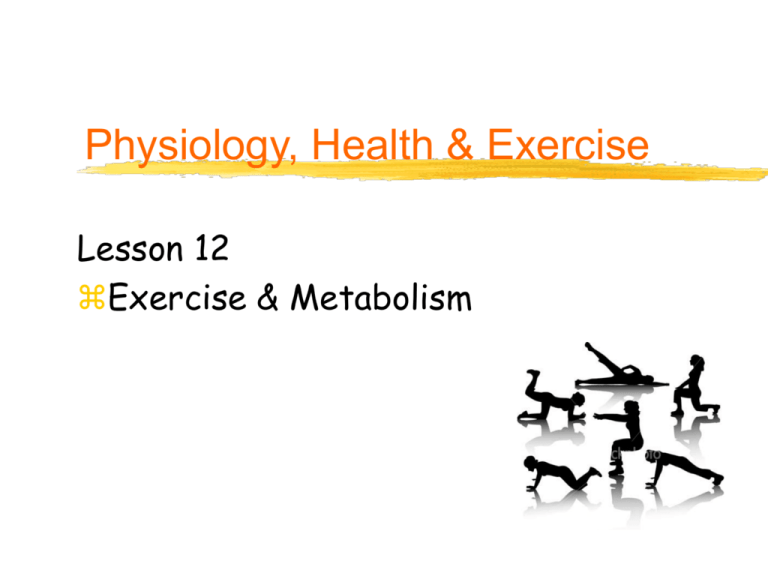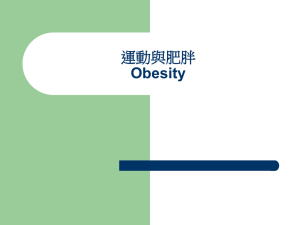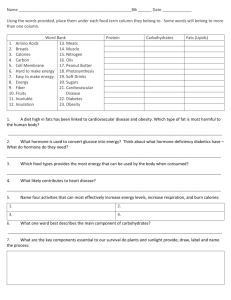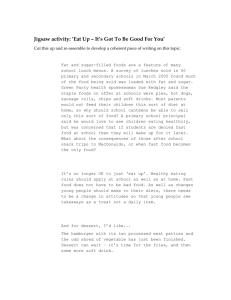Physiology, Health & Exercise
advertisement

Physiology, Health & Exercise Lesson 12 Exercise & Metabolism Exercise & metabolism Include: Need for energy Dietary recommendations for health Energy balance 2 Why does our body need energy? Write down at least 3 reasons Growth & repair of body tissues Produce heat to keep us warm Keep e.g. heart contracting Drive metabolic reactions Pregnancy & lactation 3 How do we get energy? From the food we eat! Energy measured in kJ/g or kcal/g SI unit is kJ/g Traditionally energy measured in calories, 1000 cal = 1kcal Most often used on food labellingkilocalories are also called Calories C) 1kcal = 4.18kJ 4 Which nutrients store energy? Copy and complete this table Remember 1kcal = 4.18kJ Nutrient Energy content kJ/g Carbohydrate 16 Protein 17 Kcal/g Fat 9 Alcohol 7 5 How is energy released? Potential energy in food released during respiration to synthesise ATP (cell’s energy currency) 6 Dietary recommendations for health Getting it right UK Department of Health publishes dietary guidelines Guideline Daily Allowances (GDA) Recommended % of daily energy from carbohydrate, fat & protein Estimated average requirements (EAR) 7 Guideline Daily Allowances Food labels often have GDA (Guideline Daily Allowances) A bench mark to show you the recommended daily levels Calories Fat Salt Women (GDA) 2000 70g 5g Men (GDA) 2500 95g 7g 8 Guideline Daily Allowances Also guidelines on recommended % of daily energy (excluding alcohol- which is a carbohydrate but not a nutrient!) that should come from carbohydrates protein and fat Year Carbohydrate % 1943 52 Fat % 34 Protein % 14 1995 47 38 15 2007 50 30 20 What changes have occurred in these values? Why do you think there have been changes since 1995? High fat diet will provide more energy than a low fat diet 9 Estimated average requirements (EAR) Also guidelines from Department of Health on EAR Depend on age & gender 10 Estimated average requirements (EAR) 1MJ = 1000kJ Data assumes a fairly inactive life style. Why? Age (years) EAR males MJ/day EAR females MJ/day 11-14 9.27 7.72 15-18 11.51 8.83 19-50 10.6 8.1 11 Energy balance Getting it wrong What are the consequences if we get it wrong? e.g. Consume too much energy or too little energy or % supplied by various components differs greatly from the guidelines? 12 If eat fewer kJ/day than required Negative energy balance Body energy stores used to meet the demand Regular shortfall in energy intake weight loss 13 If eat more kJ/day than required Positive energy balance Extra energy stored weight gain 14 Energy input Energy use “normal” weight Overeating/ drinking Low exercise overweight underweight Excessive exercise Stress High BMR Illness Diet Eating disorder 15 Energy balance Must consider level of activity as well as diet. e.g. high level of activity will require a diet with loads of kJ However more likely to have a poor diet, high in fat, combined with a sedentary lifestyle which causes the problems. 16 Energy balance Is evidence in UK that fat consumption has actually declined since 1990- but greater inactivity means that obesity and other conditions are on the increase 17 18 Consequences of Obesity Increases risk of CHD & stroke, even without other risk factors being present More excess fat you carry, especially around your middle, greater risk to your heart Obesity raises blood pressure & blood cholesterol levels 19 Consequences of Obesity Elevates blood lipid levels (LDL) Can greatly increase risk of type II diabetes (NIDD- non-insulin dependent diabetes) 20 Homework Monitor your energy intake over a 24 hour period Bring your data to the lesson on 08/02/2010 21






